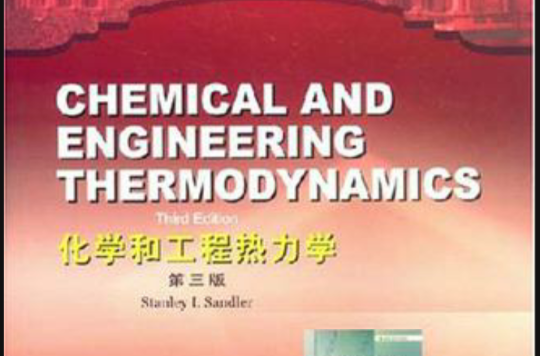圖書信息
出版社: 化學工業出版社; 第1版 (2002年8月1日)
外文書名: Chemical And Engineering Thermodynamics
叢書名: 國外名校名著
平裝: 772頁
正文語種: 簡體中文
開本: 16
ISBN: 9787502528201, 7502528202
條形碼: 9787502528201
尺寸: 25.2 x 20.2 x 3.4 cm
重量: 1.3 Kg
作者簡介
作者:(美國)桑德美(Stanley I.Sandler)
內容簡介
本書強調通過專業英語學習,建立和充實專業知識框架。教材分為“化學工業”、“化工工藝簡介”、“化學工程”和“化工前沿領域”四大部分,有利專業英語教師進行主題教學。每個單元選用的原版專著和論文均達10處以上,語言豐富,有關化學工程和工藝的英語辭彙反覆出現。教材選用的語言材料新(大部分為90年代出版物)、範圍廣(選自國外40餘種專著、教科書、專業期刊等)。學生可以通過學習這些材料,從各個層面上接觸和深化主題,使基礎比較差的學生得到明顯提高,使基礎比較好的學生能提高語言套用的熟練程度。與教材配套的教師參考資料隨書贈送交流,已受到使用該教材的20餘所高校有關教師的歡迎,並提供配套教輔材料。本教材提供了化學工程與工藝專業的比較豐富的語言材料,教師可以根據實際情況,加以深化處理,藉以提高學生在專業英語方面聽、說、寫的能力。
目錄
NOTATION
CHAPTER
INTRODUCTION
1.1 The Central Problems of Thermodynamics
1.2 A System of Units
1.3 The Equilibrium State
1.4 Pressure, Temperature, and Equilibrium
1.5 Heat, Work, and the Conservation of Energy
1.6 Specification of the Equilibrium State; Intensive and Extensive
Variables; Equations of State
1.7 A Summary of Important Experimental Observations
1.8 A Comment on the Development of Thermodynamics
Problems
CHAPTER
CONSERVATION OF MASS AND ENERGY
2.1 A General Balance Equation and Conserved Quantities
2.2 Conservation of Mass
2.3 Conservation of Energy
2.4 The Thermodynamic Properties of Matter
2.5 Applications of the Mass and Energy Balances
2.6 Conservation of Momentum
2.7 The Microscopic Equations of Change for Thermodynamics and
Fluid Mechanics (Optional)
Problems
CHAPTER
ENTROPY: AN ADDITIONAL BALANCE EQUATION
3.1 Entropy: A New Concept
3.2 The Entropy Balance and Reversibility
3.3 Heat, Work, Engines, and Entropy
3.4 Entropy Changes of Matter
3.5 Applications of the Entropy Balance
3.6 Liquefaction
3.7 Power Generation and Refrigeration Cycles
3.8 The Thermodynamics of Mechanical Explosions
3.9 The Microscopic Entropy Balance (Optional)
Problems
CHAPTER
THE THERMODYNAMIC PROPERTIES OF REAL
SUBSTANCES
4.1 Some Mathematical Preliminaries
4.2 The Evaluation of Thermodynamic Partial Derivatives
4.3 The Ideal Gas and Absolute-Temperature Scales
4.4 The Evaluation of Changes in the Thermodynamic Properties of Real
Substances Accompanying a Change of State
4.5 An Example Involving the Change of State of a Real Gas
4.6 The Principle of Corresponding States
4.7 Generalized Equations of State
4.8 The Third Law of Thermodynamics
4.9 More About Thermodynamic Partial Derivatives (Optional)
Appendix A4.1 A Program for Thermodynamic Properties
Calculations Using the Peng-Robinson Cubic Equation
ofState, PR1
Problems
CHAPTER 5EQUILIBRIUM AND STABILITY IN ONE-COMPONENT
SYSTEMS
5.1 The Criteria for Equilibrium
5.2 Stability of Thermodynamic Systems
5.3 Phase Equilibria: Application of the Equilibrium and Stability
Criteria to the Equation of State
5.4 The Molar Gibbs Free Energy and Fugacity of a Pure
Component
5.5 The Calculation of Pure Fluid-Phase Equilibrium: The Computation
of Vapor Pressure from an Equation of State
5.6 The Specification of the Equilibrium Thermodynamic State of a
System of Several Phases: The Gibbs Phase Rule for a
One-Component System
5.7 Thermodynamic Properties of Phase Transitions
Problems
CHAPTER 6THE THERMODYNAMICS OF MULTICOMPONENT
MIXTURES
6.1 The Thermodynamic Description of Mixtures
6.2 The Partial Molar Gibbs Free Energy and the Generalized
Gibbs-Duhem Equation
6.3 A Notation for Chemical Reactions
6.4 The Equations of Change for a Multicomponent System
6.5 The Heat of Reaction and a Convention for the Thermodynamic
Properties of Reacting Mixtures
6.6 The Experimental Determination of the Partial Molar Volume and
Enthalpy
6.7 Criteria for Phase Equilibrium in Multicomponent Systems
6.8 The Criteria for Chemical Equilibrium, and Combined Chemical and
Phase Equilibrium
6.9 The Specification of the Equilibrium Thermodynamic State of a
Multicomponent, Multiphase System; the Gibbs Phase Rule
6.10 Some Concluding Remarks
Problems
CHAPTER 7THE ESTIMATION OF THE GIBBS FREE ENERGY AND
FUGACITY OF A COMPONENT IN A MIXTURE
7.1 The Ideal Gas Mixture
7.2 The Partial Molar Gibbs Free Energy and Fugacity
7.3 The Ideal Mixture and Excess Mixture Properties
7.4 The Fugacity of Species in Gaseous, Liquid, and Solid Mixtures
7.5 Several Correlative Liquid Mixture (Activity Coefficient)
Models
7.6 Two Predictive Activity Coefficient Models
7.7 A Corresponding States Principle for Mixtures; The Pseudocritical
Constant Method
7.8 The Fugacity of Species in Nonsimple Mixtures
7.9 Some Comments on Reference and Standard States
7.10 A Combined Equation-of-State--Excess Gibbs Free Energy
Models
7.11 Electrolyte Solutions
7.12 Concluding Remarks
Appendix A7.1 A Statistical Mechanical Interpretation of the Entropy of
Mixing in an Ideal Mixture
Appendix A7.2 A Program for Multicomponent Vapor-Liquid
Equilibrium Calculations Using the Peng-Robinson
Cubic Equation of State, VLMU
Appendix A7.3 Multicomponent Excess Gibbs Free Energy (Activity
Coefficient) Models
Appendix A7.4 A Program for the Prediction of Activity Coefficients
and Low Pressure Vapor-Liquid Equilibrium Using the
UNIFAC Model, UNIFAC.
Problems
CHAPTER 8 PHASE EQUILIBRIUM IN MIXTURESCHAPTER 9 CHEMICAL EQUILIBRIUM AND THE BALANCE

